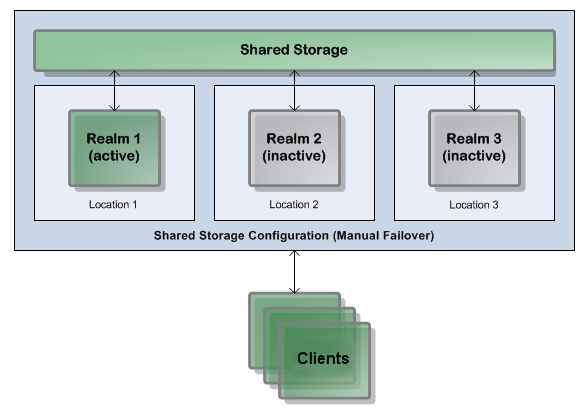About Active/Passive Clustering
Active/passive clustering is a concept that uses clustering software and special purpose hardware to minimize system downtime. Active/passive clusters are groups of computing resources that are implemented to provide high availability of software and hardware computing services. Active/passive clusters operate by having redundant groups of resources (such as CPU, disk storage, network connections, and software applications) that provide service when the primary system resources fail.
In a high availability active/passive clustered environment, one of the nodes in the cluster will be active and the other nodes will be inactive. When the active node fails, the cluster can fails over to one of the inactive nodes. This can be automated using dedicated third-party software, allowing you to start the resources on the redundant node in a predefined order (or resource dependency) to ensure that the entire node comes back up correctly.
Universal Messaging can run in an active/passive cluster environment, under Windows or UNIX. This approach does not provide load balancing or scalability.
Active/Passive Clustering Requirements
You need the following to configure a Software AG Universal Messaging active/passive cluster:

Cluster control software to manage the clusters on Windows or UNIX.

Shared Storage for sharing data files.

IP address for running the Universal Messaging cluster service.

Universal Messaging installed on the cluster nodes in the same directory path (for example, C:\SoftwareAG_UM). In the installations, the data directory path for the shared storage must be the same.
Note:
Universal Messaging installation must be identical on all cluster nodes. All instances of Universal Messaging must point to the same Universal Messaging storage files on the shared storage.
Shared Storage Configurations
In a Shared Storage configuration, multiple realm servers point to the same data directory (i.e. they share a single virtual or physical disk), but only one of the realm servers is online at any time.
In fact, shared storage must only be accessed by the active node at any one time! Multiple realm server processes accessing the same shared storage directory are likely to lead to data loss.
Shared Storage configurations are not technically a cluster, but they do provide the basic mechanism for rapid failover between realms:
 Single active realm with two inactive backup realms in a Shared Storage configuration.
Single active realm with two inactive backup realms in a Shared Storage configuration.Universal Messaging Capabilities for Active/Passive Clustering
The following capabilities of Universal Messaging enable the vendor-specific cluster control software to monitor and manage Universal Messaging in an active/passive cluster.

Functionality to start, stop, and monitor the servers.

Ability to store the server’s state information and data on a shared disk.

Ability to survive a crash and restart itself in a known state.

Ability to meet license requirements and host name dependencies.
 Single active realm with two inactive backup realms in a Shared Storage configuration.
Single active realm with two inactive backup realms in a Shared Storage configuration.